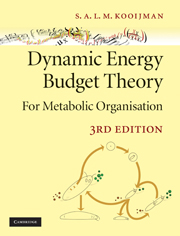
-
Select format
-
- Publisher:
- Cambridge University Press
- Publication date:
- June 2012
- October 2009
- ISBN:
- 9780511805400
- 9780521131919
- Dimensions:
- Weight & Pages:
- Dimensions:
- (246 x 189 mm)
- Weight & Pages:
- 1.14kg, 532 Pages
You may already have access via personal or institutional login
Book description
The Dynamic Energy Budget theory unifies the commonalities between organisms, as prescribed by the implications of energetics, and links different levels of biological organisation (cells, organisms and populations). The theory presents simple mechanistic rules that describe the uptake and use of energy and nutrients and the consequences for physiological organisation throughout an organism's life cycle, including the energetics of ageing and contact with toxic compounds. This new edition includes a new chapter on evolutionary aspects, and discusses methods to quantify entropy for living individuals, isotope dynamics, a mechanism behind reserve dynamics, and toxicity of complex mixtures of compounds. An updated ageing module now also applies to demand systems, new methods for parameter estimation, adaptation of substrate uptake, the use of otiliths for reconstruction of food level trajectories, the differentiated growth of body parts (such as tumours and organs) linked to their function, and many more topics.
Reviews
‘The Dynamic Energy Budget approach is refreshing, solidly grounded in biological data, supplemented with dramatic, well motivated theoretical concepts. This book is an excellent scientific product that informs and forces contemplation of issues relating to population and community ecology. The author has made a complex subject coherent.’
Thomas G. Hallam Source: Bulletin of Mathematical Biology
‘The Dynamic Energy Budget theory … should be considered by modellers as a very useful and general tool to select more ecologically sound process equations and parameters in ecological models. I can therefore recommend the book as compulsory reading for all ecological modellers.’
Sven Erik Jørgensen Source: Ecological Modelling
‘The author has made a significant contribution to the problem of modelling the dynamics of biological populations at the level of the individual by synthesising this very complicated subject into a relatively short list of general assumptions and putting the energetics of sub-models for vital rates on a solid basis.’
Jim Cushing Source: Mathematical Biosciences
‘The family of idealised models offered in this book is capable of playing a role analogous to that of Lotka-Volterra models in population dynamics … I am confident that any model(s) capable of occupying this niche will be strongly influenced by the ideas in this book.’
Roger Nisbet Source: Ecology
‘Theoretical ecologists and mathematicians with an ecological bent should find much to consider in this book.’
Source: Bulletin of the British Ecological Society
Contents
Metrics
Altmetric attention score
Full text views
Full text views help Loading metrics...
Loading metrics...
* Views captured on Cambridge Core between #date#. This data will be updated every 24 hours.
Usage data cannot currently be displayed.
Accessibility standard: Unknown
Why this information is here
This section outlines the accessibility features of this content - including support for screen readers, full keyboard navigation and high-contrast display options. This may not be relevant for you.
Accessibility Information
Accessibility compliance for the PDF of this book is currently unknown and may be updated in the future.


